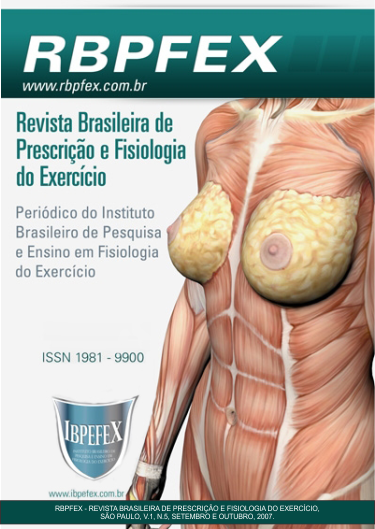Maximal oxygen uptake in professional soccer players of a potiguar team comparison between different positions
Abstract
Increasingly in soccer, is used in the aid of technology to improve the performance of athletes. Maximal oxygen uptake (VO2max) is one of the main physiological variables involved in this sport because it is in index of physical fitness and can be used as a parameter for exercise prescription. The purpose of this study was to compare the values of VO2max between professional players of different positions from a Potiguar team of soccer. Have been reviewed 36 ergospirometry tests of ABC football club athletes, with age of 26.54 ± 4.51 years, weight 75.95 ± 7.15 kg, height 1.79 ± 0.06 m and body mass index (BMI) of 23.67 ± 1.48 kg/m2 between 2005 and 2007. The athletes were allocated in five groups: goalkeepers (GO); defenders (ZG); full backs (LT); midfielders (MC), and forwards (AT). The results obtained was GO = 50.1 ± 3.04* ml/(kg.min); ZG = 56.85 ± 4.29 ml/(kg.min), LT = 59.21 ± 2.3* ml/(kg.min); MC = 57.18 ± 4.68* ml/(kg.min) and AT = 55.7 ± 5.29 ml/(kg.min). Analyzing the results it was concluded that significant difference in VO2max between GO and LA group was found, also in GO and MC group. Thus, in the studied population, goalkeepers had lower average VO2max, wile full backs and mildfielders showed the best cardiorrespiratory fitness.
References
-Aoki, M.S. Fisiologia, Treinamento e Nutrição aplicados ao Futebol. São Paulo: Fontoura, 2002.
- Balikian, P; Lourenção, A; Ribeiro, L.F.P; Festuccia, W.T.L; Neiva, C.M. Consumo máximo de oxigênio e limiar anaeróbio de jogadores de futebol: comparação entre as diferentes posições. Rev Bras Med Esporte, v. 8, n. 2, 2002.
- Barros Neto, Tl; Tebexreni, A.S; Tambeiro, V.L. Aplicações práticas da ergoespirometria no atleta. Rev. Soc. Cardiol. Estado de São Paulo, v. 11, n. 3, 2001.
- Cohen, M; Abdalla, R.J; Ejnisman, B; Amaro, J.T Lesões Ortopédicas no Futebol. Rev Bras Ortop., v. 32, n. 12, 1997.
-Edwards, A.M; Clark, N; Macfadyen, A.M; Lactate and ventilatory thresholds reflect the training status of professional soccer players where maximum aerobic power is unchanged. Journal of Sports Science and Medicine v. 2, 2003.
-Fletcher, G.F; Balady, C.G; Froelicher, V.F. e colaboradores. Exercise standards for testing and training. A statement for healthcare professionals from the American Heart Association. Circulation v. 104, p. 1694-740, 2001.
-Helgerud, J; Engen, L.C; Wisloff, U; Hoff, J. Aerobic endurance training improves soccer Performance. Med. Sci. Sports Exerc., v. 33, n. 11, 2001.
- Hoff, J; Wisloff, U; Engen, L.C; Kemi, O.J; Helgerud, J. Soccer specific aerobic endurance training. Br. J. Sports Med. v. 36, 2002.
-Klissouras, V. Heritability of adaptive variation. J Appl Physiol., v. 31, n. 3, 1971.
- Metaxas, T.I; Koutlianos, N.A; Kouidi, E.J; Deligiannis, A.P. Comparative study of field and laboratory tests for the evaluation of aerobic capacity in soccer players. J. Strength Cond. Res., v. 19, n. 1, 2005.
- Myers, J.; Buchanan, N.; Walsh, D.; Kramer, M.; Mcauley, P.; Hamilton-Wessler, M.; e colaboradores. Comparison of the ramp versus standard exercise protocols. JACC v. 17, n. 3, 1991.
- Raymundo, J.L.P; Reckers, L.J; Locks, R; Silva, L; Hallal, P.C. Perfil das lesões e evolução da capacidade física em atletas profissionais de futebol durante uma temporada. Rev Bras Ortop., v. 40, n. 6, 2005.
- Rosch, D; Hodgson, R; Peterson, L; Graf-Baumann, Mdt; Junge, A; Chomiak, J; Dvorak, J. Assessment and Evaluation of Football Performance. American Journal of Sports Medicine, v. 28, n. 5, 2000.
- Santos, J.A.R. Estudo comparativo, fisiológico, antropométrico e motor entre futebolista de diferente nível competitivo. Rev. Paul. Educ. Fís. v. 13, n. 2, 1999.
- Serra, S. Considerações sobre ergoespirometria. Arq Bras Cardiol., v. 68, n. 4, 1997.
-Shepard, R.J. Biology and medicine of soccer: an update. J Sports Sci., v. 17, 1999.
-Stolen, T; Chamari, K; Castagna, C; Wisloff, U. Physiology of Soccer. Sports Med., v. 35, n. 6, 2005.
- Yazbek P, Carvalho Rt, Sabbag Lms, Battistella LR. Ergoespirometria. Teste de Esforço Cardiopulmonar, Metodologia e Interpretação. Arq Bras Cardiol., v. 71, n. 5, 1998.
Authors who publish in this journal agree to the following terms:
- Authors retain the copyright and grant the journal the right of first publication, with work simultaneously licensed under the Creative Commons Attribution License BY-NC which allows the sharing of the work with acknowledgment of the authorship of the work and initial publication in this journal.
- Authors are authorized to enter into additional contracts separately for non-exclusive distribution of the version of the work published in this journal (eg, publishing in institutional repository or book chapter), with acknowledgment of authorship and initial publication in this journal.
- Authors are allowed and encouraged to post and distribute their work online (eg, in institutional repositories or on their personal page) at any point before or during the editorial process, as this can bring about productive change as well as increase impact and impact. citation of published work (See The Effect of Free Access).






